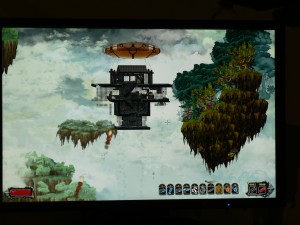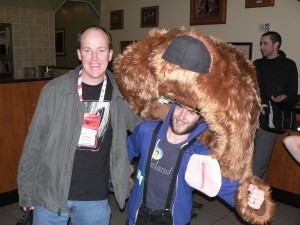
Recently, I took my first trip to Game Developers Conference (GDC). It was an all-around educational experience. Retrobooster hasn’t supplied me with a budget yet, so I bought a relatively inexpensive expo-only pass and went there just to meet people and do some networking. It was good to get a feel for the video game industry and see what people are doing. I even got to show my game to a few people and received some feedback. Following are my observations on GDC and random topics in gaming. They are completely unscientific, so don’t bet your budding indie game studio on any of them without more research.
It’s a good time to be indie
If you follow the game scene you’ve probably heard how wonderful it is to be indie due to the rise of digital distribution portals, such as Steam, Desura, and all those app stores. I didn’t meet anyone who disagrees with this theory, and GDC was overflowing with indie developers. Additionally, there are new consoles on the way that sound more indie friendly than past consoles: Ouya, Game Stick, Steam Box, and MiiPC. (MiiPC is billed as a low-power PC, but I’m guessing it will be used for simple games a whole lot.) And now Sony is courting indie developers for PS4.
Talk to engineers
As at all most shows, I had a great time talking to engineers who actually worked on the products on display. They tend to enjoy nuts-and-bolts conversations about how you can use their tools for your projects. Conversely, there is a breed of sales- and businesspeople that choose words too carefully. They have a hard time giving you straight answers, and when they decide you’re not going to buy something they want to end the conversation as soon as possible. GDC had plenty of those too. If you want to have educational conversations, people who actually make stuff are a safe bet, but watch out for smooth-talkers.
GDC Play was just as good as IGF
 GDC Play and IGF both had some excellent games, some with clever new mechanics and some that were just beautiful. GDC Play was sold to the exhibitors as a great way to reach the press, but I talked to plenty of developers there who got little or no attention from the press. It’s too bad, since there were some real gems to be seen. Here are some of my favorites from GDC Play:
GDC Play and IGF both had some excellent games, some with clever new mechanics and some that were just beautiful. GDC Play was sold to the exhibitors as a great way to reach the press, but I talked to plenty of developers there who got little or no attention from the press. It’s too bad, since there were some real gems to be seen. Here are some of my favorites from GDC Play:
* Monochroma – Simply gorgeous.
* Laika Believes – Cool premise, like a dog version of V’Ger.
* Ring Run Circus – Flip-flop mechanic with fun possibilities for skill and puzzle gameplay.
* Concerned Joe – Don’t stop moving. Very clever.
* Super Motherload – Looks like a great multiplayer experience.
* Windforge – Build destructible airships and battle dragons with them.
* Dungeon Dashers – Excellent possibilities for puzzles using characters with different abilities.
* Beyond the Depth – If I ever made an underwater screensaver, I’d want it to look a lot like this.
Use an engine or roll your own?
After meeting a lot of people in the gaming industry, I notice many of them are shocked that I’m writing Retrobooster in C++. This was a reasonable choice when I started the game in 2007, but there are probably much better game engine options today. A good game engine lets you develop a professional looking game relatively fast. However, this often costs you performance, and you can end up with a game that looks like it was made with a particular engine. If you build your own engine (or at least targeted pieces of it) you can have a big performance boost and customize your visuals more. For example, people notice the particles in Retrobooster right from the start because they stand out from the particles in most other games. That’s because they are made specifically for Retrobooster and coded from scratch with C++ and OpenGL.
To be accurate, I’m building Retrobooster with OpenSceneGraph, SDL, and SDL_mixer, which takes me about halfway to using an “engine.” These tools provide a safe, community-vetted base but not as complete a solution as a an actual game engine. As a developer, the gray area you need to navigate is how much of your game to build from scratch. I’m still happy with my choice because I have always viewed my game as a big art project, and C++ allows me to do things I have not seen in other games and pay great attention to detail. After much playtesting, I can see these things are not lost on players. But will they translate into better sales?
It’s amazing how fast technology progresses. Building a game in C++ would not have seemed strange to anyone five years ago, much like optimizing using assembly would not have seemed strange to anyone ten years ago.
A side effect of all these engines is that there is an unlimited amount of shovelware available and more every day. This can make it much too difficult to get your game noticed, especially if it’s on mobile devices, which brings me to . . .
“You have GOT to be on mobile”
I hear this from almost everyone in gaming. People will often look at your game for thirty seconds or not at all and say you need to convert to freemium and put it on phones and tablets, giving no consideration to your game’s playability with a touch screen. The more I hear this, the less I believe it. It is reminiscent of any economic bubble. And once everyone you talk to is raving about a particular bubble, it’s already too late to join the frenzy.
Part of the mobile argument usually contains disparaging remarks about PC and console gaming. Despite what you may have heard from your favorite mobile zealot, PC gaming is not dead. It’s actually growing. And not to be without a fun anecdote, there are also developers like Jake Birkett who just can’t find value in the mobile market.
I also heard broad agreement at GDC that it’s nearly impossible to get your game noticed on mobile without a lot of marketing dollars behind it. This could be a show stopper for an indie developer who can’t find a publisher. As I understand it, most mobile gamers fall into the “casual gamer” category and put little effort into searching for games. If your game isn’t on a “top ten” or “featured games” list, it will get very little attention. On the other hand, not-so-casual indie games on PC have a huge community of fans talking about them. If you make a game they like and do a huge amount of PR work, they help you get the word out.
Some people are starting to talk about this bubble is bursting, but I haven’t observed any signs of that yet. It is inevitable, though. Any new platform will eventually reach a plateau or die out completely. Before either of these happens, there is often a period of great excitement like we are now seeing in mobile gaming.
Parties
 GDC parties are touted as fully half of the GDC experience and the best place for networking. Most of the parties that I saw were too crowded and loud to do much of anything. By far the best party I attended was the Indie Art Jam. The epitome of a casual gathering, a bunch of artists and programmers raided Denny’s Restaurant for a few hours. We talked, drew some pictures, played the accordion, and showed each other our games.
GDC parties are touted as fully half of the GDC experience and the best place for networking. Most of the parties that I saw were too crowded and loud to do much of anything. By far the best party I attended was the Indie Art Jam. The epitome of a casual gathering, a bunch of artists and programmers raided Denny’s Restaurant for a few hours. We talked, drew some pictures, played the accordion, and showed each other our games.
There is an idea floating around for the ultimate GDC party. It would basically be a coffee shop filled with white boards and projection screens. Sketch some ideas, show off your latest game prototype on the screens, have a hot chocolate, and speak without needing to yell. I don’t know whose idea this was originally, but I have heard it suggested by a couple people and would love to see it actually happen.
